Hair lossin women is much rarer than in men, however, it can be noticed that the problem of excessive hair loss concerns more and more women lately. In many cases, the main culprits are aggressive beauty treatments, with which we constantly torment our hair.
Table of contents
- 1 Hair loss in women – the causes
- 2 Types of baldness
- 3 Androgenetic alopecia in women
- 4 Androgenetic alopecia in women – symptoms
- 5 Androgenetic alopecia in women – treatment
- 6 Androgenetic alopecia in women – photos
- 7 Female pattern baldness
- 8 Female pattern hair loss is not always caused by disease or genes
- 9 Home Remedies for Baldness and Hair Improvement
- 10 The role of proper nutrition and dietary supplements
Hair loss in women – the causes
Pretty, well-groomed hair is an attribute of femininity. Therefore, hair loss is a particularly embarrassing and undesirable condition for the fair sex. Excessive hair loss in women is sometimes attributed to genetic factors – if the mother or father suffered from advanced baldness, the condition is inherited, increasing in intensity as the patient grows older. However, hereditary baldness is relatively rarely observed in women, much more frequently this problem concerns men who “inherit” baldness from their fathers.
The cause of baldness in women is often a disease with which the body has to struggle (e.g. seborrheic dermatitis, ringworm, dandruff, anemia, hyperthyroidism and hypothyroidism), and increased hair loss is then one of its symptoms.
Significant hair loss may also be associated with:
- seasonal weakness of the organism,
- deficiency of certain vitamins and minerals,
- chronic stress,
- pregnancy,
- immunodeficiency.
In addition, baldness in women may be the result of hormonal disorders, taking certain medications or past therapies.
Types of baldness
The most common types of hair loss phenomenon include:
- androgenic alopecia, i.e. above-standard hair loss caused by an excess of hormones – androgens in the blood;
- alopecia areata, characterized by gradual occurrence of areas at first with thinning hair and then their complete lack, combining into larger and larger clusters
- Telogenetic alopecia, usually reversible, occurring suddenly after traumatic experiences or serious illnesses, involving a temporary lack of hair growth;
- Anagen alopecia caused by a sudden inhibition of cell division of the hair matrix and resulting in its excessive fragility and brittleness;
- seborrheic alopecia, usually accompanies other types of hair loss, but the main cause is an overproduction of sebum by the scalp, which causes damage to hair follicles and consequent thinning and loss of hair;
- scarring alopecia, this time irreversible, resulting from permanent damage to hair follicles, characterized by the formation of scars on the scalp, which prevents normal hair growth.
Androgenetic alopecia in women
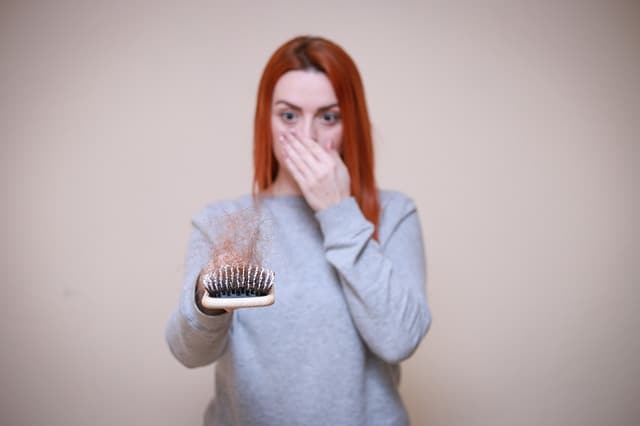
Usually this type of phenomenon is rooted in a dysregulated hormonal balance, specifically an imbalance between androgen and estrogen levels in the body. Sometimes, however, it can be the result of diseases such as tumors and tumors of the reproductive organs, thyroid diseases, anemia, Cushing’s syndrome. In addition, androgenetic alopecia in ladies can be due to many other factors.
This type of hair loss process, although it is most common in both sexes, takes place differently in women and men.
In case of men, gradual thinning of hair covers the area of forehead and temples, gradually moving towards the top of the head and often leading to complete baldness.
In ladies, it usually starts from the top of the head and very rarely ends in complete hair loss. These differences are due to different hormonal balance in both sexes.
Androgenetic alopecia in women – symptoms
Alopecia on top of the head in women, manifested by thinning and increasingly visible hair loss are in most cases the first symptoms of androgenetic hair loss. The next stage is the expansion of clearances from the top of the head to other areas, until thinning of the entire head so that the skin is visible. However, the frontal and temporal hairline is preserved. Sometimes, although significantly less frequently than in men, frontal baldness also occurs in women.
Androgenetic alopecia may occur at various stages of a woman’s life, for example after pregnancy or during menopause, but it most often appears after the age of 30. It also occurs in very young women, in their twenties, when too much androgen disrupts the functioning of hair follicles and the entire hair growth cycle. As a result, it becomes thin and weak, falls out faster and new hair grows slowly or not at all.
Androgenetic alopecia in women – treatment
Treatment of androgenetic alopecia is primarily aimed at normalizing hormone levels, primarily androgens. In addition to the use of specific supplements, pharmaceuticals or cosmetics, proper diet and lifestyle are also important.
It is mainly about providing the body with vitamins, minerals and fatty acids Omega 3, supporting the condition of hair. In turn, physical activity, by stimulating blood circulation, increases the effectiveness of the supply of nutrients to the hair follicles.
There is a wide range of cosmetics and supplements slowing down or even stopping the balding process or stimulating hair bulbs. Finally, there are specific treatments available – hair thickening, and in more serious situations, implants or even transplantation.
Hair transplantation is becoming more and more popular and, what is important, has also been available in Poland for some time. The procedure consists in taking a fragment of hairy skin (usually from the back of the head), dividing it into small fragments and implanting it in a hairless place. It is not a cheap procedure but it is certainly effective.
Androgenetic alopecia in women – photos
In the following photos you can see the typical symptoms of androgenetic alopecia in women, namely thinning and clearances, especially around the top of the head.
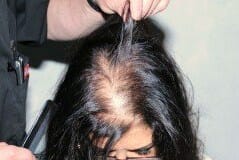
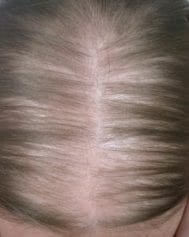
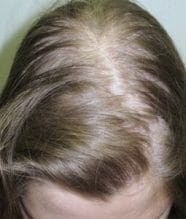
Female pattern baldness
This type of alopecia is characterized by the gradual occurrence of thinning and then completely hairless foci that enlarge over time to form increasingly larger hairless areas. In contrast, the skin is not inflamed and the process may be reversible, but it can also lead to total baldness.
The causes of alopecia areata can be varied, often an immunological disorder whereby the immune system attacks the body’s own cells, in this case the hair follicles.
Abnormalities in the functioning of internal glands, nervous system or psychosomatic disorders may also be at the base of this phenomenon.
Female pattern hair loss is not always caused by disease or genes
A frequent cause of baldness in women is exposing the hair to strong agents, which are supposed to improve its appearance, but at the same time have a destructive effect on it. Weakened and falling out hair can be responsible for:
- Bleaches – contain oxidizing substances in very high concentrations. They are more invasive than conventional hair dyes. The use of bleaches is considered the most destructive way to change hair colour. It is definitely better to avoid them. They weaken hair bulbs, cause increased hair loss and are responsible for the dryness and loss of shine of the hair. In case of thin and delicate hair they can cause a real disaster on your head.
- Hair dyes contain ammonia and oxidants, which are harmful to hair. They are less aggressive than bleaching agents but they also weaken hair and cause excessive hair loss. They are also often the cause of hair deterioration, loss of elasticity and softness, dullness and dryness of the hair.
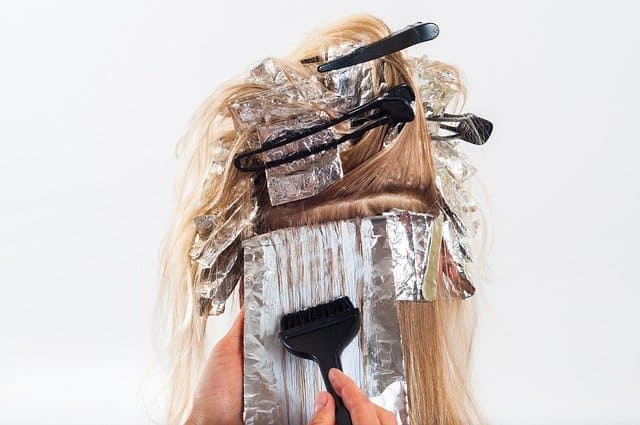
- Hair dryers, curling irons, straighteners – frequent exposure to very high temperatures has a devastating effect on hair. Not only are they prone to hair loss, weak and thin, but their structure suffers greatly – they split, lose their natural smoothness and elasticity, start to “frizz” and become excessively dry.
- Hair Care Products – Sometimes, we do not even realize how much chemicals are “sitting” in shampoos and hair styling products. Silicones, detergents, parabens, glycols, thickeners, gloss enhancers, artificial aromas… In effect, preparations that are supposed to improve the appearance of our hair, are a bomb of harmful substances for them, causing weakness and hair loss.
Home Remedies for Baldness and Hair Improvement
The main thing is to eliminate factors that may have contributed to hair loss. It is therefore worth giving up, at least for a while, dyeing, bleaching, blow-drying, all curling irons and straighteners.
You should also check the content of previously used hair care cosmetics and shampoos. The market is now a whole lot of gentle, organic shampoos and conditioners without such harmful and ubiquitous chemicals.
What is more, we have a whole range of home remedies to prevent hair loss and ensure their renewal. Just think of oiling your hair, rubbing plant extracts into your scalp or using masks.
Oiling, analogous to other treatments, is carried out over a longer period of time (about six months), regularly every few days, using for this purpose high-quality oil – evening primrose, argan, flaxseed, macadamia or coconut.
For rubs you can use, among others, aloe vera or fenugreek, for masks olive oil, yeast, eggs, yogurt, avocado.
The role of proper nutrition and dietary supplements

The good condition of the body, and therefore also of the skin and hair, is to a great extent the effect of a proper diet, in this case especially rich in vitamins A, C, E and B vitamins, copper, zinc, iron and unsaturated fatty acids.
The essence of an effective therapy will be acting on two levels – inward and outward, which means that in addition to taking care of your hair and scalp with ecological preparations, you should also take care to strengthen your body with essential nutrients.
The beneficial effects of the new diet will be magnified by using high quality, multi-ingredient dietary supplements. They should contain extracts from plants that regenerate and strengthen the hair, e.g. nettle and field horsetail, as well as copper, sulphur, zinc and biotin.
One of such supplements with proven effectiveness is Locerin – a carefully selected complex of valuable plant extracts, vitamins and minerals.
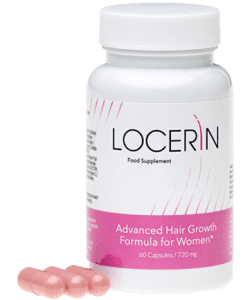
Locerin contains, among others, extract from nettle, field horsetail, bamboo and one of the latest achievements of cosmetology, an extract from organic green pea sprouts – AnaGain™ Nu, which significantly inhibits hair loss and stimulates new hair growth. Locerin also contains biotin and minerals important for the condition of hair.
In the case of any therapy, however, you need to remember that the guarantee of its effectiveness is regularity, regularity and patience, especially that you have to wait a while for the effects.
Sources:

